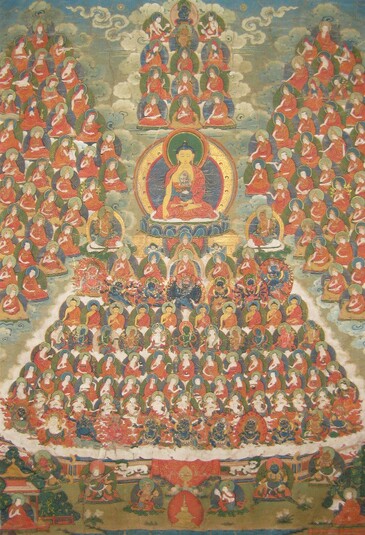
Item: Refuge Field (Buddhist) - Gelug Lineage
| Origin Location | Tibet |
|---|---|
| Date Range | 1800 - 1899 |
| Lineages | Gelug and Buddhist |
| Material | Ground Mineral Pigment on Cotton |
| Collection | Private |
Classification: Object/Concept
Gelug Field of Accumulation. At the center is Shakyamuni Buddha (Tibetan: sha kya tu pa, sang gye. English: the Sage of the Shakya Clan, Enlightened One): surrounded by lineage teachers, Indian adepts, meditational deities, protectors and wealth deities - the Field for the Accumulation of Merit (Tib.: tsog shing). This painting and a number of others labeled as Gelug Refuge Field Shakyamuni 'B' appear to have been created using a common model or possibly a wood block print model.
Tibetan: Tsog shing Sanskrit: Buddha Shakyamuni
Sanskrit: Buddha Shakyamuni Tibetan: Sang gye sha kya tu pa
Tibetan: Sang gye sha kya tu pa
See the Gelug Refuge Field Main Page, Refuge Fields with Shakyamuni Buddha at the center and the Gelug Refuge Field Outline.
In the Gelug Tradition of Tibetan Buddhism there are numerous Refuge Field composition types distinguished both by central figure and also by support (i.e. lotus or tree): (1) Shakyamuni Buddha, (2) Je Tsongkapa, (3) Pabongka Design, and (4) Lotus Support, and (5) Block Print. The first three types are depicted at the peak of a wish-fulfilling tree, seated on a throne and lotus. The fourth type is placed only on a lotus blossom. The two general types of central figures for all types of Refuge Fields are Shakyamuni Buddha and Je Tsongkapa. The variation of the two subject figures depend on the intention, purpose and function of the painting. The former is a Lama Chopa (Shakyamuni) Refuge Field and the latter a Lamrim Lineage (Tsongkapa) Refuge Field.
The various sections of the refuge field have been numbered according to hierarchy and coloured only for purposes of contrast and separation. The descriptions and explanations below follow the numbered hierarchy.
1. Shakyamuni Buddha with a small primordial Buddha - Vajradhara - at the heart.
2. (Yellow) The Direct Lineage with the primordial Buddha Vajradhara at the top, two mahasiddhas at the sides, Orange Manjushri below holding a sword up with the proper right hand. Below that is Umapa followed by Tsongkapa with a Gelug teacher below and at the sides.
3. (Blue) Yogachara Lineage with Asanga at the top followed the the Indian teachers and then Atisha and Domton descending down into the Gelug lineage teachers. Seated next to the Buddha's throne is the bodhisattva Maitreya.
4. (Red) Madhyamaka Lineage with Nagarjuna at the top followed the the Indian teachers and then Atisha and Domton repeated descending down into the Gelug lineage teachers. Seated next to the Buddha's throne is the bodhisattva Manjushri.
5. (Green) Six Living Teachers likely from the time of the paintings creation.
6. (Amber) Meditational Deities (ishtadevata): from the left are Hayagriva 'Secret Accomplishment', Mahachakra Vajrapani, Akshobhyavajra Guhyasamaja, Vajrabhairava, Heruka Kalachakra, Chakrasamvara and Hevajra.
7. (Purple) The Buddhas of the Ten Directions.
8. (Violet) The Eight Great Bodhisattvas: Akashagarbha, Avalokiteshvara, Kshitigarbha, Maitreya, Manjushri, Nivarana-vishkhambhin, Samantabhadra and Vajrapani. At the center is green Shyama Tara along with white Sita Tara on the left and white Lokeshvara in the form of Semnyi Ngalso on the right.
9. (Aqua) The Early Buddhist Patriarchs, the actual lineage of teachers and students that descended from Shakyamuni Buddha to Shariputra, Maudgalyayana and others.
10. (Yellow) Sixteen Great Arhats: Abheda, Ajita, Angaja, Bakula, Chudapantaka, Gopaka, Kalika, Kanakabharadvaja, Kanakavatsa, Nagasena, Pantaka, Pindola Bharadvaja, Rahula, Shribhadra, Vajriputra, Vanavasin.
11. (Blue) Dakas and Dakinis are a catagory of Tantric helpers, guides and assistants along the Tantric Buddhist path. They are not always represented in the composition of Refuge Field paintings. It is also difficult to define them or to come up with individual names for each of them. They are generally always referred to as a catagory.
12. (Red) The Wisdom Protectors (Jnana Dharmapala): starting from the left are Kartaridhara Mahakala, Sita Shhadbhuja Mahakala, Yama Dharmaraja (outer, Yama Dharmaraja (secret), Yama Dharmaraja (inner). At the center is Shadbhuja Mahakala. On the right are Chaturmukha Mahakala, Panjarnata Mahakala, Chaturbhuja Mahakala, Vaishravana Riding a Lion, and Begtse Chen.
13. (Green) The Worldly Protectors (Lokapala) represented by the Four Great Guardian Kings: Virupaksha (West) is on the far left, red in colour. Dhritarashtra (East) is to the right and white in colour holding a stinged instrument. Virudhaka (South) is blue in colour and holding a sword followed by Vaishravana (North) at the far right, yellow in colour and holding a victory banner.
At the bottom center is gold stupa with a red aura. Above to the left is Brahma, yellow in colour, holding a golden wheel. At the upper right side is Vishnu, white in colour, holding a white conch shell. Both are kneeling in a respectful manner. At the lower right corner is a generic donor figure modeled after a famous iconographic pose of Kedrubje Geleg Pal Zangpo. At the bottom left is a monastic figure in a pavilion - likely the donor and commissioner of the painted Refuge Field composition.
Jeff Watt 1-11-2011
Subject: Refuge Field Main Page
Subject: Refuge Field, Gelug (Main Page)
Subject: Refuge Field, Gelug (Copies)
Collection of WGA

